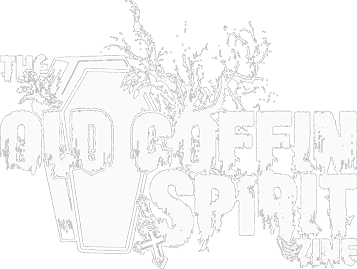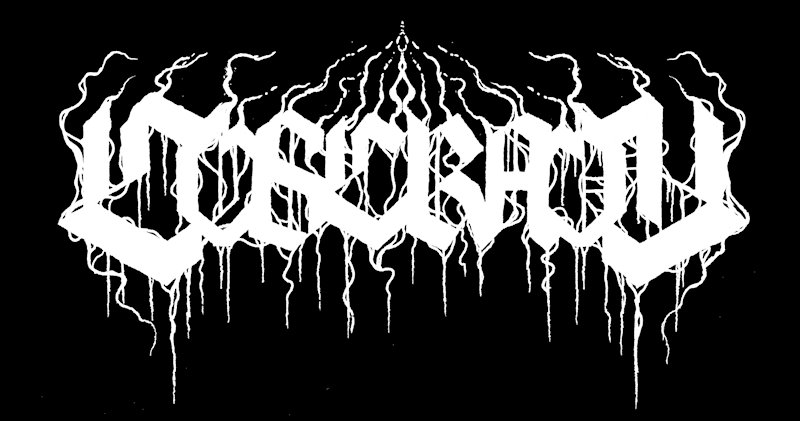
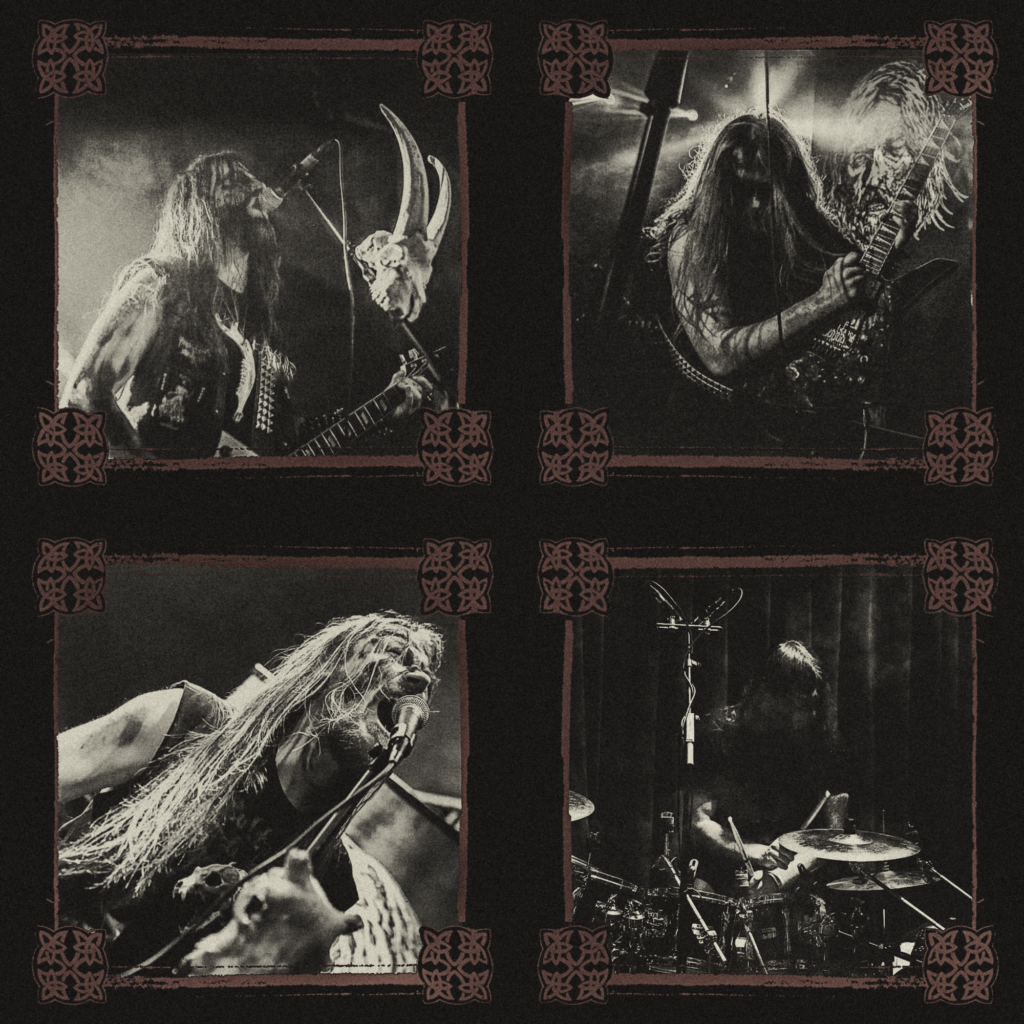
O fundador Ciáran Ó Críodáin nos falou sobre a rica cultura da Irlanda, o devastador disco de estreia, visões, influências e preferências, num bate-bola imperdível.
Saudações Ciáran, estamos empolgados por apresentar o COSCRADH nas páginas do “The Old Coffin Spirit”, obrigado por reservar um tempo para nós, e por ter aceitado a entrevista. A banda foi fundada em 2014 em Dublin, certo? Por favor, nos fale um pouco sobre a história da banda, como vocês começaram a tocar juntos?
Ciáran Ó Críodáin: Por volta de 2014 houve um renascimento do metal underground na Irlanda, com bandas como SODB, ZOM, MALTHUSIAN, SLIDHR, FUIL NA SEANCHOILLE, FROM THE BOGS OF AUGHISKA, WIZARDS OF FIRETOP MOUNTAIN e PRIMORDIAL e MOURNING BELOVETH ainda fortes. A loja de discos “Into the Void” ajudou a criar uma cena em Dublin alguns anos antes. Eu estava morando em Belfast na época e comecei a procurar membros para uma demo do Black/Death, eventualmente os encontrando pelo país.
COSCRADH é um ótimo nome (eu imagino como ele deve ser pronunciado devidamente), e eu sei que ele significa algo como carnificina/massacre triunfante em Irlandês arcaico. Qual é a importância da língua Irlandesa e as suas raízes culturais para a identidade da banda e a sua forma de compor?
Ciáran Ó Críodáin: O nome é pronunciado coss-kraa ou cuss-kraa dependendo do dialeto. Eu sou de Connemara, que é uma área de língua gaélica irlandesa no oeste da Irlanda. O desejo de conservar a língua e a tradição é muito forte aqui. Ao escrever letras e riffs/noise para COSCRADH, tudo vem do que sabemos melhor, que é a história e o folclore irlandês. Estamos todos individualmente explorando a natureza selvagem, montanhas, monumentos antigos, túmulos e ruínas de nosso país a cada poucas semanas, faça chuva ou faça sol. Como todos os países do “velho mundo”, há uma riqueza de história em cada canto, contos obscuros, guerras, rituais, desastres naturais. Levaria muitas vidas para aprender sobre tudo isso. É parte de nós e, portanto, parte da identidade da banda.
Até onde eu sei, há duas línguas diferentes com o nome Gaélico: A Irlandesa e a Escocesa, que foi levada à Escócia por colonos Irlandeses antigos. Você fala ambas? Quão próximas são essas duas línguas, e qual delas você costuma utilizar para escrever?
Ciáran Ó Críodáin: Falo e escrevo muitas de nossas letras em gaélico irlandês. As línguas são semelhantes o suficiente para entender quando escritas, mas é difícil quando faladas, a menos que você ouça as duas com frequência. “Cladh Hàlainn” é um sítio arqueológico de morte ritual que tem um folclore antigo e inesquecível ligado a ele, transmitido por milênios. Está localizado em South Uist, na Escócia, onde o gaélico escocês é falado. Neste local há evidências de sacrifício humano druídico de quatro pessoas. A música será a única escrita neste idioma por causa da localização geográfica.
Como vocês trabalham em relação à composição? Todos os membros da banda têm a oportunidade de compartilhar e implementar suas ideias, e agregar seus toques pessoais? Após algumas mudanças de lineup, podemos considerar a formação atual a mais afiada até hoje?
Ciáran Ó Críodáin: Não existe uma fórmula exata para escrever como tal. A maioria da composição inicial das músicas e riffs deste álbum é minha, e trazidas para o estúdio para posterior dissecação, ou outras vezes sentado com o “Jason” bebendo “Poitín” (Aguardente tradicional Irlandês, normalmente destilado de cascas de batata) e trabalhando juntos em riffs e estruturas. “Jason” é o responsável por toda a insanidade principal, seus próprios riffs e ideias estruturais, bem como backing vocals, uma guitarra de 12 cordas e um bandolim na gravação. Os gritos doentios lembrando “banshees” que você ouve ao longo do álbum vêm de “Hick”, junto com outros vocais animalescos, composição do ruído, samples, uma série de pedais de efeitos, apito de estanho, um apito asteca de morte cerimonial e seus próprios riffs de baixo. “Boban”, que só se juntou em março deste ano, já foi capaz de tocar o álbum na íntegra na primeira vez que nos encontramos, e estará envolvido na composição do próximo lançamento. Todo mundo traz o máximo que tem, e eu considero essa a melhor e mais forte encarnação da banda até hoje.
Vamos falar agora do incrível álbum de estreia “Nahanagan Stadial”, programado para lançamento no início de agosto. Primeiramente, sobre a impactante arte de capa, uma bela peça do artista sérvio conhecido como “Khaos Diktator Design”. Qual é o conceito amparando a ilustração? Ele chegou a ouvir uma demo do album?
Ciáran Ó Críodáin: Fizemos uma pré-produção em 2020 e a enviamos a ele, e depois alguns vídeos de sala de ensaio com uma longa explicação dos conceitos por trás das letras. Ele teve total liberdade com o design da capa, e foi concluído antes da master final. Retrata os Penhascos de Moher. A música “Feast of the Epiphany” é sobre a grande tempestade conhecida como “Oiche na Gaoithe Móire” que foi responsável por dizimar o país. Os maremotos vieram do Oeste, e dizem ter superado os grandes penhascos de Moher em Co. Clare, uma parte da Irlanda com as paisagens mais impressionantes. É também uma combinação da letra por trás de “Nahanagan Stadial”, que foi a repentina reviravolta da civilização, exterminando os caçadores / coletores originais com a chegada de uma nova era do gelo, remodelando a ilha em sua forma atual. Ele já conhecia a banda, estava entusiasmado com o novo álbum e queria nos dar uma ótima peça para a capa. Ele também está interessado em música irlandesa, então batemos um bom papo sobre isso.
Quando eu ouvi o novo álbum pela primeira vez, e fui ouvir novamente a Demo e os Eps, minha impressão foi a de que o Blackened Death do COSCRADH é pesadamente inspirado pela demência dos primórdios do metal extremo Sul-Americano, de atos como SARCÓFAGO e HOLOCAUSTO, bem como por divindades ancestrais do War Metal. Quais seriam as suas maiores influências e seus heróis no Metal?
Ciáran Ó Críodáin: Com certeza há algumas influências Sul-Americanas lá. O HOLOCAUSTO é selvagem e o “I.N.R.I.” do SARCÓFAGO tem sido definitivamente uma influência contínua sobre nós, assim como MYSTIFIER, MORTEM, VULCANO e SEPULTURA antigo também! Nossas outras influências vêm de todas as partes: GOATLORD, TORMENTOR, MASTER’S HAMMER, VOMITOR, TEITANBLOOD, DIOCLETIAN, CULTES DES GHOULES, ROOT, RIDE FOR REVENGE, CELTIC FROST, HELLHAMMER, BATHORY, SLAYER, POSSESSED, BEHERIT, DEICIDE, MORBID ANGEL e AUTOPSY.
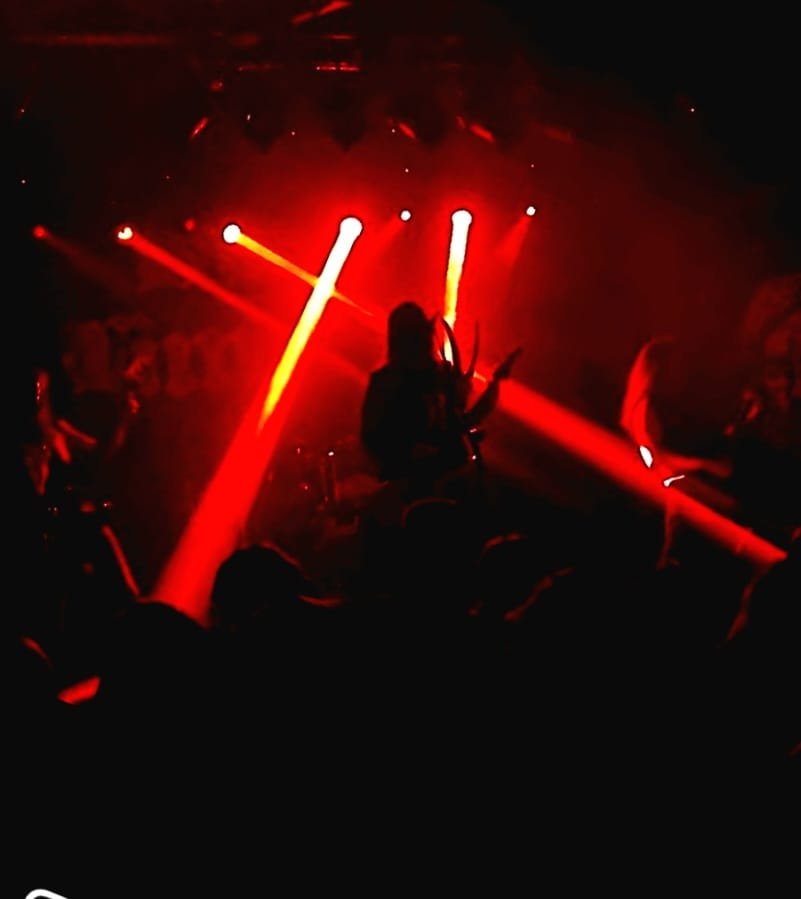
Quanto tempo vocês levaram trabalhando no álbum “Nahanagan Stadial”, e como foi o processo de gravação? O estúdio “Last Light Recordings” parece ser como uma segunda casa para o COSCRADH a esse ponto, e certamente, por um bom motivo.
Ciáran Ó Críodáin: Começamos a escrever seriamente para o álbum no início de 2020, depois que o ex-guitarrista “John McNeill” deixou a banda. Gravamos uma demo de pré-produção de 4 faixas para o “Darragh” (Darragh O’ Laoghaire – proprietário da gravadora) da “Invictus Productions” por volta de agosto de 2020, para mostrar que ainda estávamos vivos, e ele decidiu lançar duas dessas faixas como o EP de 7” “Mesradh Machae”. Aproveitamos o momento para escrever “Cladh Hàlainn” e a faixa-título “Nahanagan Stadial” no final do ano, e começamos as sessões de gravação do álbum em março, depois terminamos a mixagem/masterização em agosto de 2021.
Você já leu nossa resenha, creditando ao álbum 9,5/10, portanto é óbvio que nós curtimos todas as faixas. Ainda assim, eu tenho uma música favorita, a monstruosa “Cladh Hàlainn”. Fale-nos mais sobre a composição desse som, e o som destruidor de guitarras. Concluindo, você tem uma música favorita no trabalho?
Ciáran Ó Críodáin: ”Cladh Hàlainn” foi escrita principalmente durante um período de bloqueios de covid-19, onde um limite de viagem de 2 km foi aplicado por postos de controle da Garda (polícia) em toda a cidade. Com tudo fechado, era o momento perfeito para focar em escrever riffs isoladamente. Eu trouxe meus riffs para o estúdio, “Jason” trouxe os dele, e montamos a música com todos os quatro contribuindo. O álbum se torna mais insano à medida que prossegue, e queríamos que ele soasse completamente selvagem à medida que avançasse para o lado B, o lado gaélico. Esta canção em particular é um ritual de sacrifício humano falado em gaélico escocês, a partir da perspectiva do Druida, um sacrifício aos deuses sob as estrelas com sua profunda compreensão celta do cosmos. O barulho durante a “outro’ é da espaçonave Cassini que passou por Júpiter e mais tarde gravou esses sons da atmosfera de Saturno no início dos anos 2000.
O disco apresenta uma atmosfera extremamente densa e opressiva. Como exatamente vocês trabalham para atingi-la, os elementos Noise continuam sendo peças-chave?
Ciáran Ó Críodáin: Utilizar noise e samples para conectar todo o disco já se tornou uma tradição nossa, e é um elemento chave do som. Tentamos tornar o noise relevante para o conteúdo lírico com samples de gritos de raposa, trombetas de batalha, ventos solares, outros instrumentos e pedais de efeitos. O “Hick” usa muitos pedais e instrumentos diferentes, e tem uma rara expertise com eles. Também utilizamos o noise / sampling ao vivo.
A “Invictus Productions” é um dos meus selos europeus preferidos, eles seguem lançando álbuns de altíssimo nível e apresentando grandes bandas ao mundo. Vocês têm trabalhado com eles desde a criação da banda, então o que você pode nos dizer a respeito dessa parceria e do Modus Operandi deles?
Ciáran Ó Críodáin: O “Darragh” está com a banda desde o início, quando enviamos a ele gravações brutas de ensaios em 2015. Existem apenas 3 bandas irlandesas no selo e, ao longo dos anos, todos nos tornamos amigos de bebida e temos alguns “crossovers” entre os membros da banda no selo. Ele é obviamente um fã de todas as bandas da gravadora, dá suas opiniões sobre mixagens, masters e artes de capa, aparece no estúdio para gravações, vai aos shows, sai em turnê com bandas da gravadora, marca shows e faz turnês que as bandas nunca seriam capazes de se organizar, além de toneladas de outras atividades que não mencionei ou que não conheço a fundo. O “Invictus/Last Light Warehouse and Studio” tornou-se um ponto de encontro e um centro para a nossa pequena cena underground.
Vocês ainda chamam o estilo da banda de Gaelic War Metal? Como você definiria o som do COSCRADH’s para alguém que nunca tenha ouvido a sua música, utilizando-se apenas de algumas poucas palavras?
Ciáran Ó Críodáin: Nós escrevemos canções de guerra e morte em gaélico, e combina com o som. O “Darragh” apelidou o nosso som com esse nome, e eu concordo que ele faz todo sentido.
Vocês têm tocado um bom número de shows ao vivo, eu assisti ao vídeo da apresentação de maio “Live in Opium”, onde o COSCRADH abriu para o MGLA tocando o novo álbum em sua totalidade. A banda descarrega uma tonelada de energia sobre o palco. Como vocês se sentem tocando ao vivo, e como têm sido as primeiras reações às novas músicas?
Ciáran Ó Críodáin: Nós nem sempre favorecemos o cenário ao vivo no passado, mas com essa formação estamos determinados a dar o máximo de energia que pudermos ao vivo. Tivemos uma boa resposta nesses shows com o MGLA e da própria banda. Depois de dois anos e meio queríamos representar nosso som com o máximo de violência possível.
Como é sua relação com o Metal Brasileiro? Suas bandas e álbuns preferidos?
Ciáran Ó Críodáin: Mencionei sobre isso nas influências, então em termos de álbuns eu teria que dizer: “Goetia”, “Wicca”, “I.N.R.I.”, “Rotting”, “Schizophrenia”, “Morbid Visions”, “Beneath the Remains”, “Arise”, “Bloody Vengeance”, mas eu deveria conhecer bem mais que isso.
Quais são suas bandas preferidas tocando Metal Extremo atualmente?
Ciáran Ó Críodáin: Mais recentemente MALOKARPATAN, NEGATIVE PLANE, FORCE OF DARKNESS, DEATHCULT, PRIMITIVE WARFARE, ABHORRATION, GRAVE MIASMA, WULKANAZ, DEATH LIKE MASS, CULTES DES GHOULES, NIFELHEIM, VENEFIXION, HORNS AND HOOVES, SLUTVOMIT, INITIATION (SWE), PERVERTED CEREMONY e WITCHCRAFT (FIN).
A Ilha Esmeralda (Irlanda) é considerada um país religioso, com o Ateísmo vagarosamente crescendo ao longo dos anos recentes. Como você enxerga a religião organizada? O foco da banda nunca foi o tradicional satanismo das bandas de metal, mas sim o passado culturalmente rico e historicamente banhado em sangue dos Celtas e Gaélicos.
Ciáran Ó Críodáin: Nosso foco está na história antiga e nos mundos arcaicos dos Gaélicos e Celtas. A Irlanda está se tornando mais ateia, mas não temos interesse nas visões políticas ou religiosas das pessoas modernas. Muito da nossa história mais antiga está preservada no catolicismo irlandês. Por mais que tenham sido destrutivos em relação a história, os cristãos foram forçados a usar a religião e a cultura Gaélica/Celta para converter gradualmente a população, de modo que, em alguns casos, as únicas lembranças remanescentes podem ser encontradas lá.
Oito anos após seus primeiros passos, o COSCRADH trilhou um belo caminho, e o “Nahanagan Stadial” está chegando para solidificar o nome da banda entre os Grandes do Metal Extremo da Irlanda. O que virá adiante, o que vocês gostariam de conquistar com a banda?
Ciáran Ó Críodáin: Provavelmente seremos mais ativos com lançamentos, com sangue novo e nova energia no nosso acampamento. Além disso, gostaríamos de tocar mais fora do país, não estamos na estrada desde 2019, então vamos tentar sair para a Europa ou outro lugar novamente, se possível.
Mais uma vez agradeço o seu tempo e atenção, CIÁRAN! Foi um prazer resenhar o álbum e bater esse papo com você. Por favor, fique à vontade para deixar uma mensagem a todos os leitores do “The Old Coffin Spirit Zine”! Sláinte! (Saúde!)
Ciáran Ó Críodáin: O interesse no metal underground no Brasil e na América do Sul é fudido, excelente! Slán libh! (Adeus!)
ENGLISH VERSION:
Ancient Gaels and Celts Bloodbath keeping Ireland on top of War Metal


Founder Ciáran Ó Críodáin spoke to us about Ireland’s rich culture, the devastating debut album, his visions, influences and preferences, check it out.
Greetings Ciáran, it’s great to be featuring COSCRADH on The Old Coffin Spirit’s pages, thanks for granting us some time for the interview. The band was founded around 2014 in Dublin, right? Please, tell us a bit about the band’s history, how did you guys start jamming?
Ciáran Ó Críodáin: Around 2014 there was a revival of underground metal in Ireland, with bands like SODB, ZOM, MALTHUSIAN, SLIDHR, FUIL NA SEANCHOILLE, FROM THE BOGS OF AUGHISKA, WIZARDS OF THE FIRETOP MOUNTAIN and PRIMORDIAL and MOURNING BELOVETH still going strong. “Into the Void record store” had a part in helping create a scene in Dublin a couple of years earlier. I was living in Belfast at the time and started looking for members for a Black/Death demo, eventually finding them around the country.
COSCRADH is a great name (I wonder how it would be properly pronounced), and I’m aware it means triumphant slaughter / massacre in old Irish. How important is the Irish language and your cultural roots to the band’s identity and songwriting?
Ciáran Ó Críodáin: It’s pronounced coss-kraa or cuss-kraa depending on the dialect. I’m from Connemara, which is an Irish Gaelic speaking area in the west of Ireland. The desire to conserve language and tradition is very strong here. When writing lyrics and riffs/noise for COSCRADH, it comes from what we know best which is Irish history and folklore. We are all individually out exploring our country’s wilderness, mountains, ancient monuments, tombs and ruins every few weeks, rain or shine. Like every country in the “old world” there’s a wealth of history in every corner, obscure tales, war, ritual, natural disaster. It would take many lifetimes to learn about all of it. It’s a part of us, and therefore a part of the band’s identity.
As far as I know, there are two different languages named Gaelic: The Irish and the Scottish, which was taken to Scotland by ancient Irish settlers. Do you speak both? How close are these two languages, and which one do you use when writing?
Ciáran Ó Críodáin: I speak and write much of our lyrics in Irish Gaelic. The languages are similar enough to understand when written but it’s difficult when spoken unless you are frequently hearing both. “Cladh Hàlainn” is an archaeological site of ritual death which has an unforgotten ancient folklore attached to it passed down for millennia. It’s located in South Uist in Scotland where Scots Gaelic is spoken. On this site there is evidence of druidic human sacrifice of four people. The song will be the only one written in this language because of the geographical location.
How do you work when it comes to composition? Do all members get to share and implement their ideas, and add their personal touches? After a few lineup changes, can we consider the current formation the tightest yet?
Ciáran Ó Críodáin: There’s no exact formula for writing as such. The majority of the initial song composition and riffs on this album are from myself and brought to the studio for further dissection, or other times by sitting with “Jason” drinking “Poitín” (traditional Irish booze, usually made from potato skins) and working out riffs and structures together. “Jason” is responsible for all of the lead insanity, his own riffs and structural ideas, as well as backing vocals, with a 12-string guitar and mandolin on the recording. The sickening bansheesque shrieks you hear across the album come from “Hick”, along with other animalistic vocals, composition of the noise, sampling, theremin, an array of effects pedals, tin whistle, Aztec death whistle, and his own bass riffs. “Boban”, who only joined in March this year, could already play the album in full the first time we met up, and will be involved in writing for the next release. Everyone brings the maximum they’ve got, and I’d consider this the best and strongest incarnation of the band to date.
Now, let’s talk about the amazing first album “Nahanagan Stadial”, set for release in the beginning of August. Firstly, the striking artwork, a beautiful piece by the Serbian artist known as “Khaos Diktator Design”. What’s the concept behind the illustration, did he get to listen to a rough mix, or a demo?
Ciáran Ó Críodáin: We did a pre-production back in 2020 and sent him this, and later some practice room videos with a lengthy explanation of the concepts behind the lyrics. He had free reign with the cover design, and it was completed before the final master. It depicts the Cliffs of Moher. The song “Feast of the Epiphany” is about the great storm known as “Oiche na Gaoithe Móire” which was responsible for decimating the country. Tidal waves came from the west and are said to have topped the great Cliffs of Moher in Co. Clare, a part of Ireland with the most stunning landscapes. It’s also a combination of the lyrics behind “Nahanagan Stadial” which was the sudden overturning of civilization wiping out the original hunter/gatherers with the arrival of a new ice age, reshaping the island into its current form. He was already aware of the band, was enthusiastic about the new album and wanted to give us a great piece for the cover. He’s also interested in Irish Music, so we had a good bit of discussion around this.
When I first listened to the new album and got back to listen to the demo and EPs, the first impression was that COSCRADH’s Blackened Death is heavily inspired by the early South American madness of acts like SARCÓFAGO and HOLOCAUSTO, as well as ancient War Metal Deities. What would be your major influences and Metal heroes?
Ciáran Ó Críodáin: For sure there’s some South American influences in there. HOLOCAUSTO are savage and SARCÓFAGO “I.N.R.I.” has definitely been an ongoing influence on us as well as MYSTIFIER, MORTEM, VULCANO and early SEPULTURA also! Our other influences come from all over the place: GOATLORD, TORMENTOR, MASTER’S HAMMER, VOMITOR, TEITANBLOOD, DIOCLETIAN, CULTES DES GHOULES, ROOT, RIDE FOR REVENGE, CELTIC FROST, HELLHAMMER, BATHORY, SLAYER, POSSESSED, BEHERIT, DEICIDE, MORBID ANGEL and AUTOPSY.
How long did you take working on “Nahanagan Stadial”, and how was the recording process? “Last Light Recordings” seems to feel like home to COSCRADH at this point, and certainly for a good reason.
Ciáran Ó Críodáin: We started seriously writing for it at the beginning of 2020 after former guitarist “John McNeill” left the band. We recorded a 4-track pre-production demo for “Darragh” at “Invictus” around August 2020 to show that we were still alive, and he decided to release two of those tracks as the 7” “Mesradh Machae”. We used the momentum to write “Cladh Hàlainn” and the “Nahanagan Stadial” title track at the end of the year, and started the album recording sessions in March, then finished the mixing/mastering in August 2021.
You’ve read our review, rating the album 9.5/10, so it’s obvious we dig all tracks. Still, I do have a favorite track, the monstrous “Cladh Hàlainn”. Tell us more about its composition, and the crushing guitar sound. Also, do you have a personal favorite?
Ciáran Ó Críodáin: “Cladh Hàlainn” was mostly written during a period of the covid lockdowns where a 2km travel limit was enforced by Garda (police) checkpoints all over the city. With everything closed it was a perfect time to focus on writing riffs in isolation. I brought my riffs to the studio, “Jason” brought his, and we assembled the song with all four of us giving an input. The album becomes more insane as it continues and we wanted this to sound completely wild as it progresses into side B, the Gaelic side. This song in particular is a human sacrifice ritual spoken in Scots Gaelic from the perspective of the Druid, a sacrifice to the gods under the stars with his profound Celtic understanding of the cosmos. The noise in the outro is from the Cassini spacecraft which flew by Jupiter and later recorded these sounds of Saturn’s atmosphere in the early 00s.
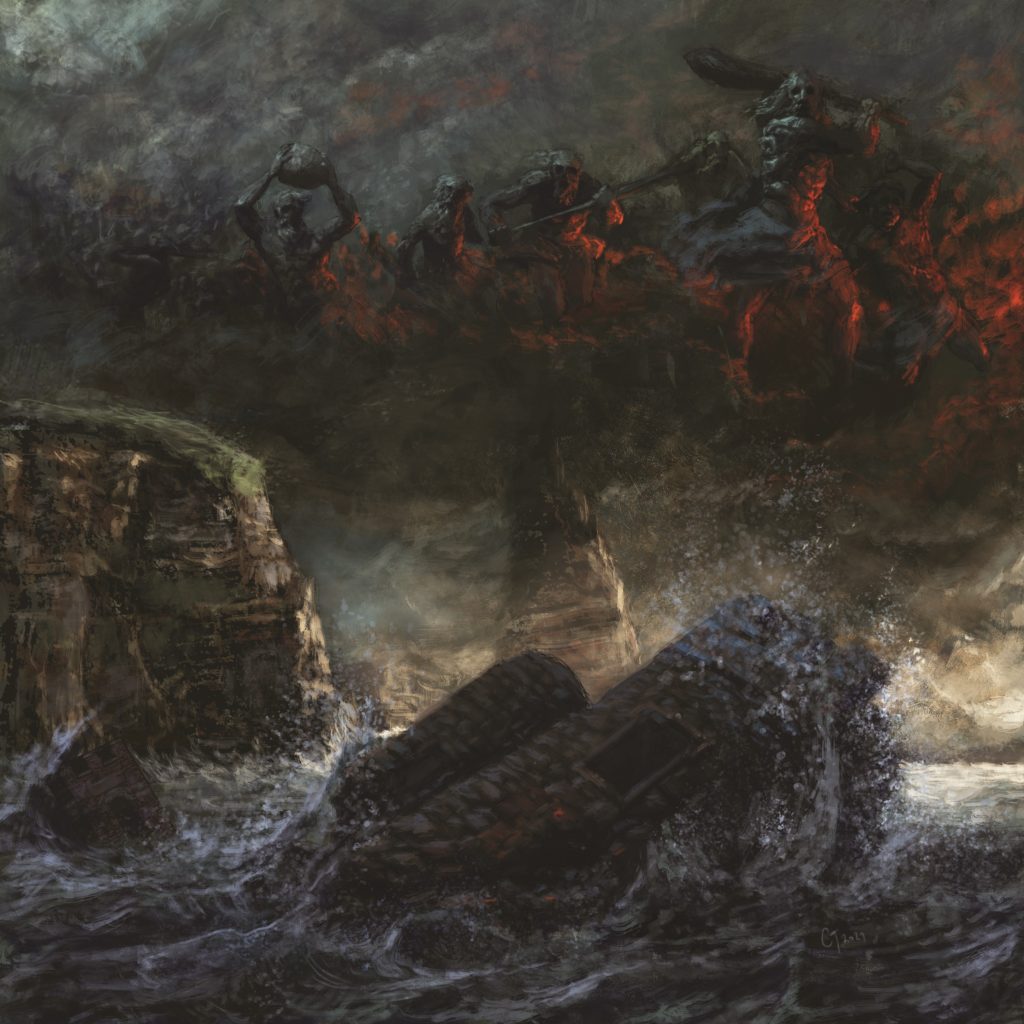
The album presents an extremely dense and oppressive atmosphere. How exactly do you work to achieve it, are the noise elements still key?
Ciáran Ó Críodáin: Utilizing noise and samples to connect the whole record has now become a tradition of ours, and is a key element of the sound. We try to make noise relevant to the lyrical content with samples of fox cries, battle horns, solar winds, other instruments, and effects pedals. “Hick” uses a lot of different pedals/instruments and has a rare expertise with them. We also perform the noise / sampling live.
“Invictus Productions” is one of my favorite European labels, they keep releasing top-notch records and introducing great bands to the world. You’ve been working with them since the bands’ inception, so what can you tell us about this partnership and their modus operandi?
Ciáran Ó Críodáin: “Darragh’s” been into the band from the beginning when we sent him rough jamroom recordings back in 2015. There are only 3 Irish bands on the label and over the years we’ve all become drinking buddies and have some crossover between band members on the label. He’s obviously a fan of all the bands on the label, gives his opinions on mixes, masters and artwork, shows up to the studio for recordings, comes to the gigs, heads off on tour with label bands, sets up gigs and tours the bands would never have been able to organize themselves, and tons of other activities that I’ve failed to mention or don’t know about. The “Invictus/Last Light Warehouse and Studio” has become a meeting point and hub for our small underground scene.
Do you still dub the band’s style as Gaelic War Metal? How would you define COSCRADH’s sound for someone who has never listened to your music, using just a few words?
Ciáran Ó Críodáin: We write songs of war and death in Gaelic and it matches the sound. “Darragh” has dubbed it with this name, and I’d agree that it does what it says on the tin.
You’ve been playing a good number of live shows, I’ve watched a video from last May’s “Live in Opium” gig, where COSCRADH supported MGLA playing the new album in full. The band displays a shitload of energy onstage. How do you guys feel up there, and how have been the first reactions to the new songs live?
Ciáran Ó Críodáin: We hadn’t always favored the live setting in the past but with this lineup we are determined to give it as much energy as we can live. We had a good response at these shows with MGLA, and from the band themselves. After two and a half years we wanted to represent our sound with as much violence as possible.
How is your relationship with Brazilian Metal? Any favorite bands and albums?
Ciáran Ó Críodáin: Stated in the influences above so album wise I would have to say: “Goetia”, “Wicca”, “I.N.R.I.”, “Rotting”, “Schizophrenia”, “Morbid Visions”, “Beneath the Remains”, “Arise”, “Bloody Vengeance”, but I should know way more than this!
What are your favorite bands playing Extreme Metal these days?
Ciáran Ó Críodáin: More recently MALOKARPATAN, NEGATIVE PLANE, FORCE OF DARKNESS, DEATHCULT, PRIMITIVE WARFARE, ABHORRATION, GRAVE MIASMA, WULKANAZ, DEATH LIKE MASS, CULTES DES GHOULES, NIFELHEIM, VENEFIXION, HORNS AND HOOVES, SLUTVOMIT, INITIATION (SWE), PERVERTED CEREMONY and WITCHCRAFT (FIN).
The Emerald Isle is considered a religious country, with atheism slowly growing over recent years. How do you see organized religion? The band’s focus has never been the traditional Satanism of metal acts, but the rich, historically blood-soaked past of the Celts.
Ciáran Ó Críodáin: Our focus is on ancient history and archaic worlds of the Gaels and the Celts. Ireland is becoming more atheist but we’ve zero interest in the political or religious views of modern people. A lot of our oldest history is preserved in Irish Catholicism. As much as they were destructive towards it, Christians were forced to use Gaelic/Celtic religion and culture to gradually convert the population, so in some cases the only remaining memories can be found there.
Eight years after taking its very first steps, COSCRADH has come a long way, and “Nahanagan Stadial” arrives to solidify the band’s name among Ireland’s Extreme Metal Greats. What’s next, what would you like to achieve with the band?
Ciáran Ó Críodáin: We’re probably going to be more active with releases with new blood and new energy in the camp. Also, we would like to play outside of the country more, we haven’t been out on the road since 2019 so we’re going to try and get out to Europe or elsewhere if possible.
Thanks again for your time and attention, CIÁRAN! It was a pleasure reviewing the album and talking to you. Please, feel free to leave a message to all “The Old Coffin Spirit Zine” readers! Sláinte! (Cheers!)
Ciáran Ó Críodáin: The interest in underground metal in Brazil and South America is fucking excellent, Slán libh! (Goodbye)
